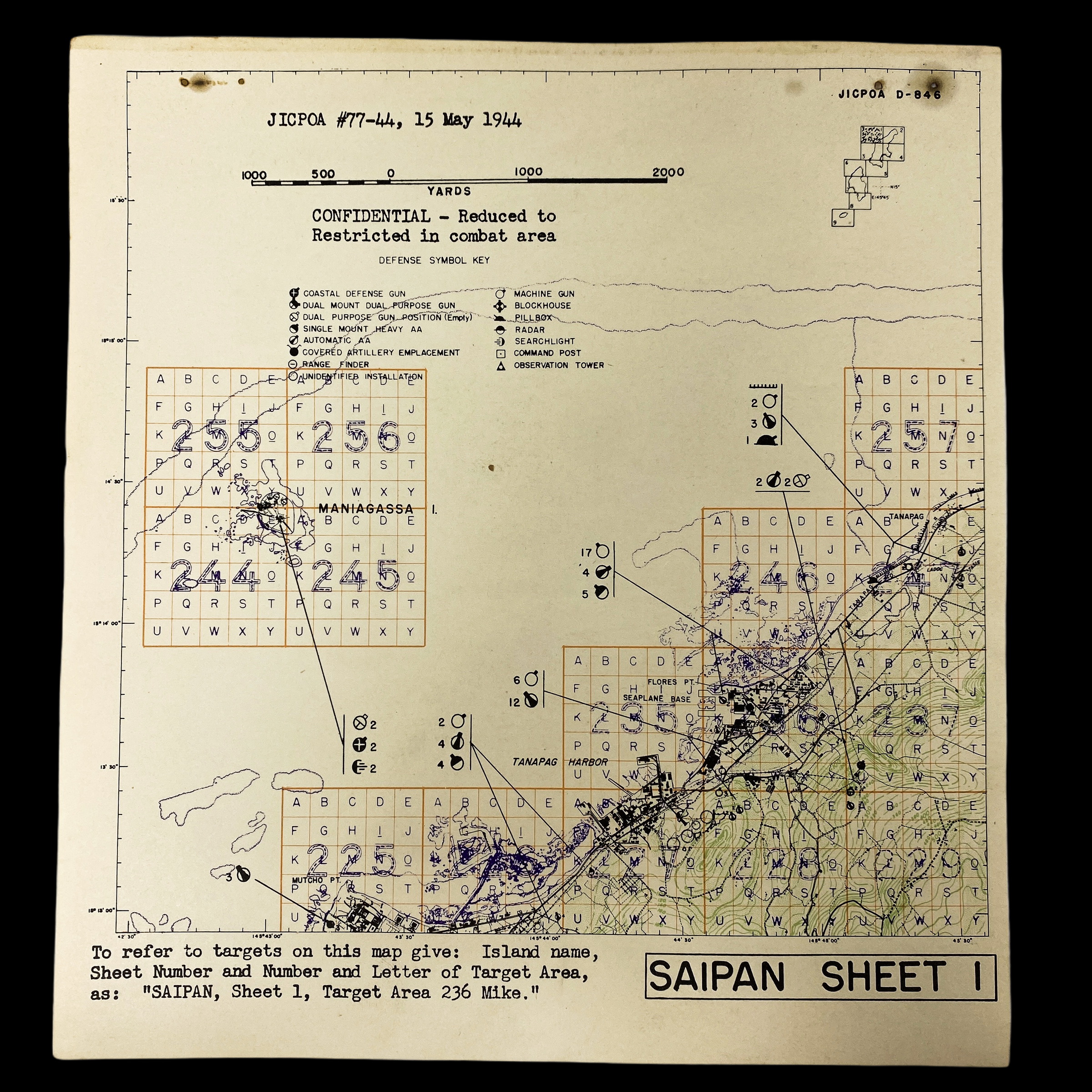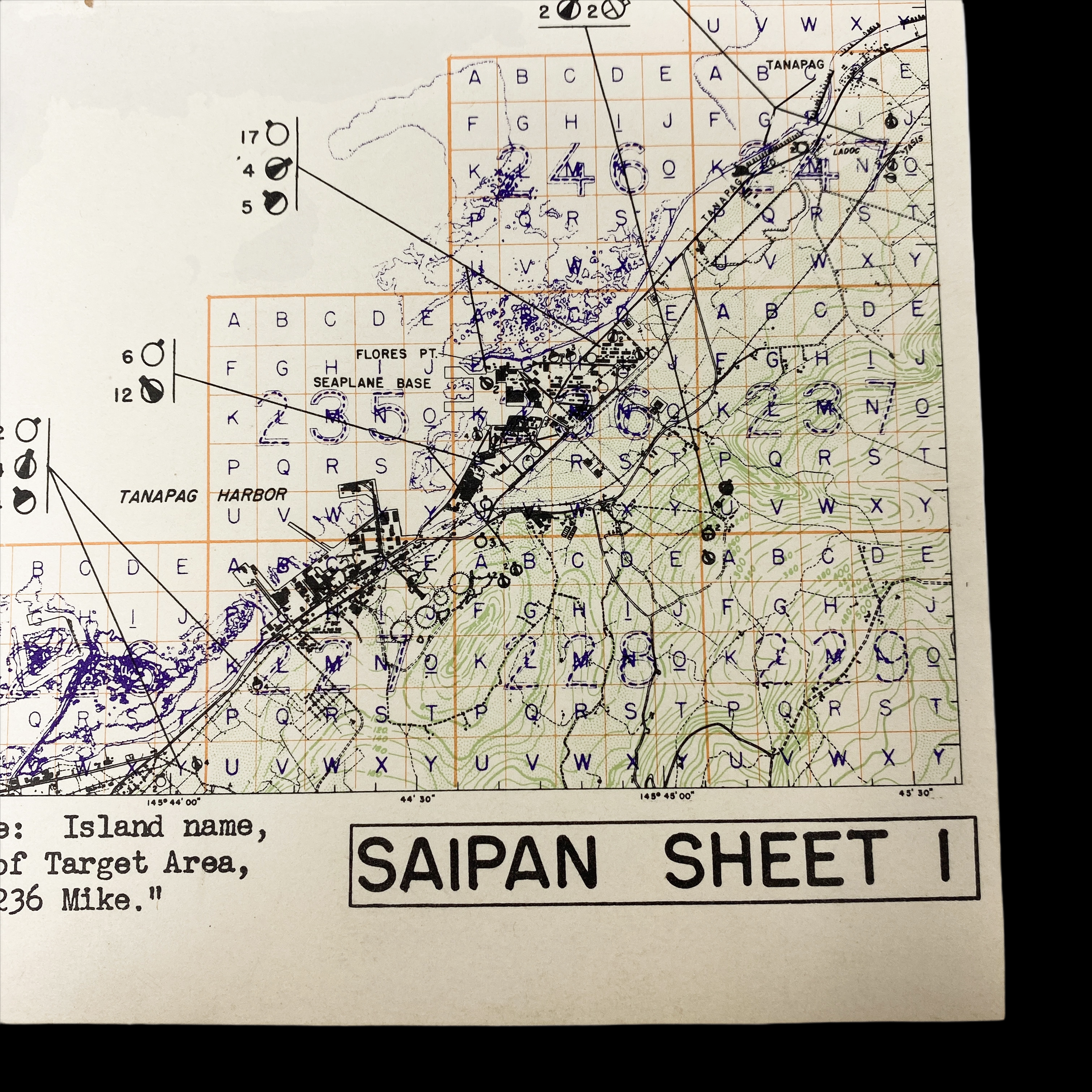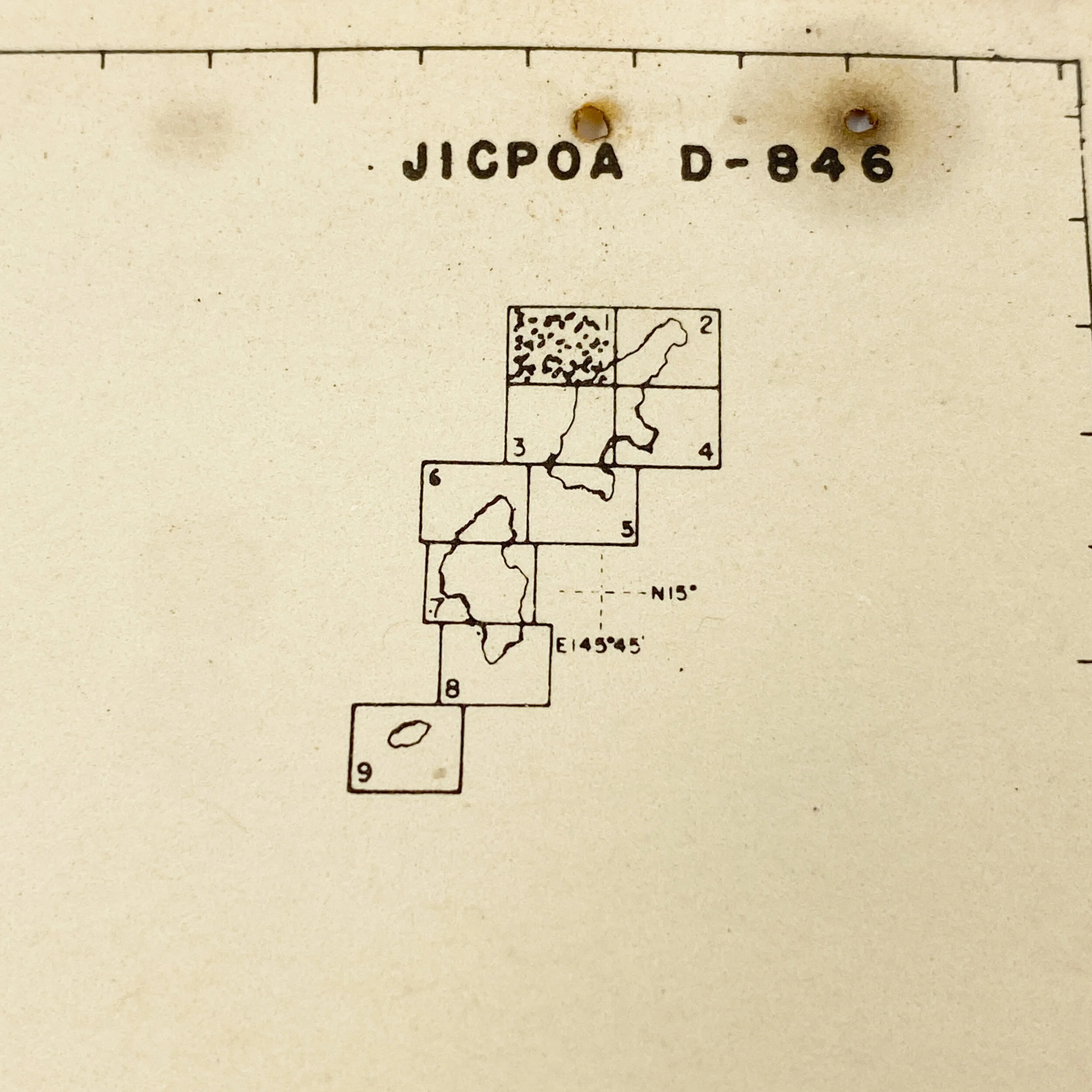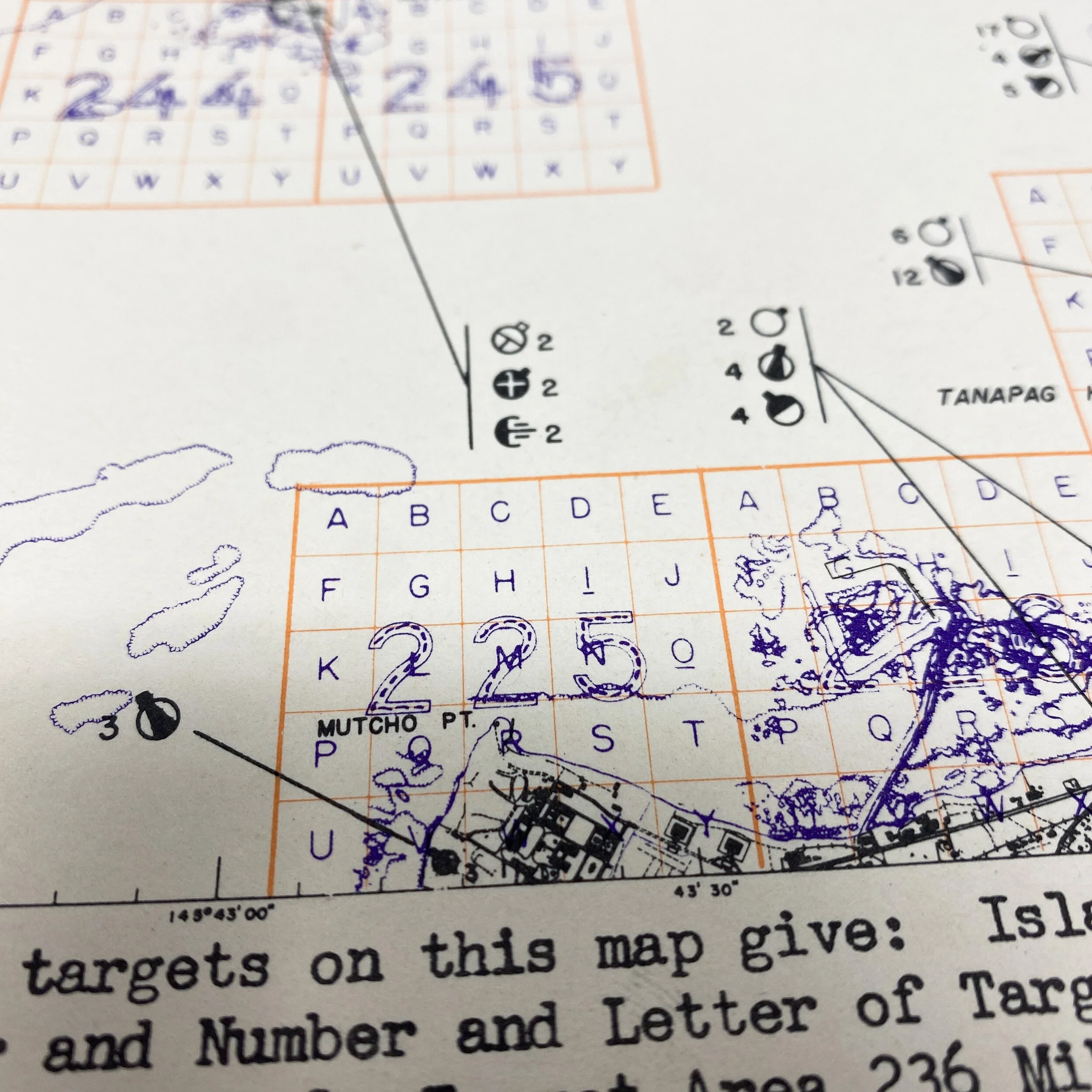*1944 ‘CONFIDENTIAL’ Saipan Target Map (D-Day SCARLET 1 & SCARLET 2 Beachheads)- Lt. Moore - U.S.S. Enterprise (CV-6) Air Group - Operation Forager













*1944 ‘CONFIDENTIAL’ Saipan Target Map (D-Day SCARLET 1 & SCARLET 2 Beachheads)- Lt. Moore - U.S.S. Enterprise (CV-6) Air Group - Operation Forager
Size: 8 x 8.75 inches
Letter of Authenticity included.
*Shows the exact locations of Japanese defenses and fortifications of the Saipan D-Day amphibious landing beachheads designated SCARLET 1, SCARLET 2. Also features Tanapag Village, Seaplane Base, Tanapag Harbor, and Mutcho Point.
This extremely rare ‘CONFIDENTIAL’ World War II Joint Intelligence Center Pacific Ocean Area (JICPOA) map is marked #77-44 and is dated May 15th, 1944. In the actual USS Enterprise ‘After Action’ reports it states, “It is recommended that "Top Secret" material - Operation Plans and Orders - be reclassified downward to "Secret or Confidential" prior to the start of an operation by a sufficient length of time to permit of adequate and timely distribution to subordinate officers and pilots concerned.”
Titled ‘Saipan Sheet 1’ this map was carried and used by Lt. Moore who served as an American pilot on the USS Enterprise (CV-6) Air Group. This rare air target map was carried by Lt. Moore as U.S. aircraft patrols and search and destroy missions were conducted by the USS Enterprise (CV-6) and its Air Group during the invasion of Saipan against Japanese forces. It was on this island where Enterprise pilots gave direct support to the landings on Saipan on 15 June, and covered the troops ashore for the next two days. Aware of a major Japanese attempt to break up the invasion of Saipan, Admiral Spruance, now Commander 5th Fleet, positioned TF 58 to meet the threat. Following the Battle of the Philippine Sea, Enterprise and her Task Group continued to provide air support for the invasion of Saipan through 5 July.
Enterprise and Task Force 58 spent nearly a month in the Mariana Islands, preparing for and supporting the Saipan landings on 15 June 1944, striking targets on Guam and Rota, and engaging in the fifth major carrier battle of the war: the Battle of the Philippine Sea, 19-20 June 1944. Enterprise played a significant role in the battle: her Combat Information Center (CIC) directed much of the action during the "Turkey Shoot" on the 19th, while an Air Group Ten search was the first to locate the Japanese fleet on the afternoon of the 20th. Also notable in this report are the growing number of night air missions, led by the Big E's VF(N)-101 and VT-10 squadrons.
This map was used to not only spot and call out targets designations from the air, but also to allow USS Enterprise Air Group pilots the ability to accurately and efficiently locate and destroy designated targets given over radio communications to their formations in the air. This map gives the directions on how to appropriately use this map and call accurate coordinates. What makes this map even more special is the ‘‘CONFIDENTIAL’ marked Japanese defense on the island including: “coastal defense guns, automatic AA, covered artillery emplacements, range finders, machine guns, block houses, pill boxes, radar stations, search lights, command post, and observation towers.
Saipan/Guam/Battle of the Philippine Sea - USS ENTERPRISE ACTION REPORT - 6-29 June 1944
On 6 June 1944, ENTERPRISE, as a unit of Task Group 58.3 (Rear Admiral J.W. Reeves, Jr., USN, Commander Carrier Division FOUR, U.S.S. ENTERPRISE, Flagship) departed Majuro Atoll, and proceeded in accordance with reference (b) toward Saipan, Mariana Islands. At 1300 on 11 June 1944 at a point 229 miles East of Saipan, this vessel launched a fighter sweep to start the combat actions connected with the occupation of Saipan. Description of subsequent actions naturally divides itself into three phases corresponding to the developments.
First Phase - Bombardment and Invasion of Saipan.
From 11 June to 17 June 1944, ENTERPRISE conducted air operations in the area as ordered. Repeated strikes were launched to eliminate enemy air opposition, to destroy AA and coast defense guns and defenses, and to provide air support for the amphibious landing and advance of our ground troops in the seizure of Saipan.
At dusk on 15 June, Task Group 58.3 was vigorously attacked by a formation of Jap torpedo planes. The group of seven VB(M) made a determined attack on our port bow, meeting a tremendous volume of fire from the Task Group, six planes going down in flames.
ENTERPRISE shot down two and assisted on a third. A bomb from an undetected plane exploded in the water about 750 yards ahead on the port bow just before the torpedo planes reached that point. One torpedo plane dropped a torpedo about 1000 yards on the port bow, the torpedo running parallel to the ship at a distance of about 50 yards. One man was killed and 10 suffered slight shrapnel wounds from cross fire coming from other ships.
Strikes on Guam were conducted on 17 June in addition to refueling.
Second Phase - Engagement with the Japanese Fleet.
Action with the Japanese appearing imminent, the Task Group reformed and sought contact. On 17 and 18 June, ENTERPRISE launched 325 mile searches to the westward which were negative. At 0200 on 19 June, fifteen torpedo planes were launched on a special 300 mile night radar search and attack mission. No contact was made. Starting about 1030 Task Force 58 was attacked by the aircraft of the Japanese Fleet in successive waves. The flight deck was cleared. ENTERPRISE fighters joined the Combat Air Patrol in intercepting the Jap attacks, and the Bomber and Torpedo planes bombed Orote Airfield on Guam. The task force fighters shot down most of the attacking enemy planes, ENTERPRISE VF claiming 19. A few enemy planes were able to make attacks on this group of ships. These were shot down spectacularly by ships' gunfire, ENTERPRISE claiming destruction of one plane and assisting in two others. One of our VF planes was shot down over Guam.
Early on 20 June, a 325 mile search was launched, with negative results. On the second search at 1547 ENTERPRISE planes made contact report on the Jap Fleet bearing 287° (T) distance 214 miles. At 1624 a strike of 12 VF, 5 VT, 11 VB was launched. Ten direct hits are claimed on two enemy carriers with several damaging near misses on these ships and a CVE. It is believed on HAYATAKA class carrier was probably sunk. A ZUIHO class carrier was severely damaged, a CVE damaged by near misses, and 12 enemy planes were shot down. It was very dark when the striking group returned with little fuel left. All but five ENTERPRISE planes landed safely aboard various carriers, and the personnel of the five planes were recovered from water landings by destroyers. One VF pilot shot down over the target was recovered by rescue seaplane.
At 0230, 21 June ENTERPRISE launched two VT planes to regain contact with the Jap Fleet and trail it. These planes carried out their mission, reporting accurately the composition of the remaining Jap Forces, which was at a distance outside the range of the search and attack group of 12 VF, 8 VB, 8 VT launched at 0605. All carriers reshuffled to recover own planes. Rescue operations were singularly successful.
Third Phase - Neutralization of Guam and Pagan Islands.
From 21 June to 29 June, the Task Group carried out strikes as ordered on Guam and Pagan Islands to neutralize the airfields and destroy defense guns and military installations. Successful night interceptions were made in an attempt to cut off Jap planes flying into the Marianas from the Southwest, three enemy planes being thus destroyed on the night of 28 June and one on the night of 27 June 1944.
The entire action resulted in the loss of sixteen aircraft of this vessel, eight lost in combat and eight operationally. Four pilots were killed or are missing and three air crewmen were killed or are missing.
USS Enterprise (CV-6) Return to duty:
Captain Matthias Gardner relieved Ginder on 7 November. Back at Pearl Harbor on 6 November, Enterprise left four days later to provide close air support to the 27th Infantry Division landing on Makin Atoll, during the Battle of Makin, from 19–21 November 1943. On the night of 26 November, Enterprise introduced carrier-based night fighters to the Pacific when a three-plane team from the ship broke up a large group of land-based bombers attacking TG 50.2. Two of the three planes returned to the ship, with LCDR Edward "Butch" O'Hare the only casualty. After a heavy strike by aircraft of TF 50 against Kwajalein on 4 December, Enterprise returned to Pearl Harbor five days later.
The carrier's next operation was with the Fast Carrier Task Force in softening up the Marshall Islands and supporting the landings on Kwajalein, from 29 January-3 February 1944. Then, Enterprise sailed, still with TF 58, to strike the Japanese naval base at Truk Lagoon in the Caroline Islands, on 17 February. Again Enterprise made aviation history, when she launched the first night radar bombing attack from a U.S. carrier. The twelve torpedo bombers in this strike achieved excellent results, accounting for nearly one-third of the 200,000 tons of shipping destroyed by aircraft.
Detached from TF 58 with escorts, Enterprise launched raids on Jaluit Atoll on 20 February, then steamed to Majuro and Espiritu Santo. Sailing on 15 March in TG 36.1, she provided air cover and close support for the landings on Emirau Island (19–25 March). The carrier rejoined TF 58 on 26 March, and for the next 12 days, joined in a series of strikes against the islands of Yap, Ulithi, Woleai, and Palau. After a week's rest and replenishment at Majuro, Enterprise sailed on 14 April to support landings in the Hollandia (currently known as Jayapura) area of New Guinea, and then hit Truk again from 29–30 April.
On 6 June 1944, she and her companions of TG 58.3 sortied from Majuro to join the rest of TF 58 in attacking the Marianas Islands. Striking Saipan, Rota, and Guam from 11–14 June, Enterprise pilots gave direct support to the landings on Saipan on 15 June, and covered the troops ashore for the next two days.
Aware of a major Japanese attempt to break up the invasion of Saipan, Admiral Spruance, now Commander 5th Fleet, positioned TF 58 to meet the threat.
Battle of the Philippine Sea:
On 19 June 1944, Enterprise was one of four carriers of Task Group 58.3 under the command of Rear Admiral John W. Reeves' during the largest carrier aircraft battle in history: the Battle of the Philippine Sea. For over eight hours, airmen of the United States and Imperial Japanese navies fought in the skies over TF 58 and the Marianas. Over the course of two days, a total of six American ships were damaged, and 130 planes and a total of 76 pilots and aircrew were lost. In sharp contrast, American carrier aircraft, with a major assist from U.S. submarines, sank three Japanese carriers (Hiyō, Shōkaku, and Taihō), and destroyed 426 carrier aircraft, losses from which Japanese naval aviation would never recover. Enterprise participated both in the defense of the fleet and in the subsequent early-evening strike against the Japanese task forces. During the chaotic after-dark recovery of the air strike, a fighter and a bomber came aboard simultaneously, but fortunately did not cause an accident. A planned midnight strike against the Japanese fleet by night-flying Enterprise pilots was cancelled because of the recovery and rescue operations required after the dusk attack. After the battle, Enterprise and her Task Group continued to provide air support for the invasion of Saipan through 5 July. She then sailed for Pearl Harbor and a month of rest and overhaul. During this time, Gardner was replaced by Commander Thomas Hamilton on 10 July before he was relieved in his turn by Captain Cato Glover on 29 July. Back in action on 24 August, the carrier sailed with TF 38 in that force's aerial assault on the Volcano and Bonin Islands from 31 August – 2 September, and Yap, Ulithi, and the Palaus from 6–8 September.
Battle of Leyte Gulf:
After operating west of the Palau Islands, Enterprise joined other units of TF 38 on 7 October and set course to the north. From 10–20 October, her aviators flew over Okinawa, Formosa, and the Philippines, blasting enemy airfields, shore installations, and shipping in preparation for the assault on Leyte. After supporting the Leyte landings on 20 October, Enterprise headed for Ulithi to replenish, but the approach of the Japanese fleet on 23 October called her back to action.
In the Battle of Leyte Gulf (23–26 October), Enterprise planes struck all three groups of enemy forces, battering battleships and destroyers before the action ended. The carrier remained on patrol east of Samar and Leyte until the end of October, then retired to Ulithi for supplies. During November, her aircraft struck targets in the Manila area, and at the island of Yap. She returned to Pearl Harbor on 6 December 1944 and Glover was replaced by Captain Grover B. H. Hall on 14 December.Sailing on 24 December for the Philippines, Enterprise carried an air group specially trained in night carrier operations; as the only carrier capable of night operations, she left Oahu with her hull code changed from CV to CV(N), the "N" representing "Night". She joined TG 38.5 and swept the waters north of Luzon and of the South China Sea during January 1945, striking shore targets and shipping from Formosa to Indo-China including an attack on Macau. After a brief visit to Ulithi, Enterprise joined TG 58.5 on 10 February 1945, and provided day and night combat air patrol for TF 58 as it struck Tokyo on 16–17 February. She then supported the Marines in the Battle of Iwo Jima from 19 February – 9 March, when she sailed for Ulithi. During one part of that period, Enterprise kept aircraft aloft continuously over Iwo Jima for 174 hours.Departing Ulithi on 15 March, the carrier continued her night work in raids against Kyūshū, Honshū, and shipping in the Inland Sea of Japan. Damaged lightly by an enemy bomb on 18 March, Enterprise entered Ulithi six days later for repairs. Back in action on 5 April, she supported the Okinawa operation until she was damaged on 11 April—this time by a kamikaze—and was forced back to Ulithi. Off Okinawa once more on 6 May, Enterprise flew patrols around the clock as kamikaze attacks increased. On 14 May 1945, she suffered her last wound of World War II when a kamikaze Zero, piloted by Lt. J.G. Shunsuke Tomiyasu, destroyed her forward elevator, killing 13 and wounding 68.The carrier sailed for and was fully repaired at the Puget Sound Navy Yard. Near ready, with all planes aboard at the degaussing/demagnetizing range off the Strait of Juan de Fuca when the Nagasaki bombing ended the war on 9 August 1945.
Comprehensive WWII combat history of USS Enterprise (CV-6):
The Yorktown class aircraft carrier, USS Enterprise (CV-6) was commissioned at Newport News, Virginia, on May 12, 1938. Relocating to the Pacific, she was at sea during the Japanese Attack on Pearl Harbor on December 7, 1941. Three days after, she became the first U.S. Navy warship to sink a Japanese warship, submarine I-70, and later that month participated in the Wake Island expedition. In April, Enterprise covered the Dootlittle Raid on Japan and participated in the Battle of Midway that June, where her planes helped sink three Japanese aircraft carriers and a cruiser. During the Guadalcanal Campaign, she covered the landings and participated in the battles of Eastern Solomons and Santa Cruz Islands. Despite being damaged in both battles, she launched aircraft to assist the ships involved in the Naval Battle of Guadalcanal. In late 1943 and early 1944, Enterprise took part in the Gilberts and Marshall invasions and air attacks on the Japanese in the Central and Southern Pacific. In the summer of 1944, she participated in the Marianas operation and the Battle of the Philippine Sea, followed with the largest naval battle in history, the Battle of Leyte Gulf in October. In February 1945, Enterprise took part in the Iwo Jima invasion, then raids on the Japanese home islands and the Okinawa campaign in April. Due to damage received by two kamikaze attacks in April and May, she returned to the United States with the distinction of being the most decorated U.S. Navy warship during the war. Following Japan's surrender, she helped transport U.S. servicemen back to the United States. Decommissioned in February 1947, Enterprise was re-designated (CVA-6) in October 1952 and then to (CVS-6) in August 1953. Despite efforts to turn her into a museum ship, she was sold for scrapping in July 1958.